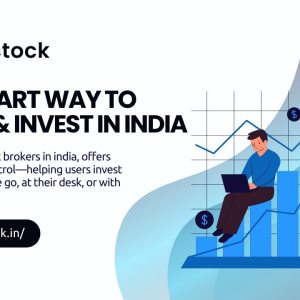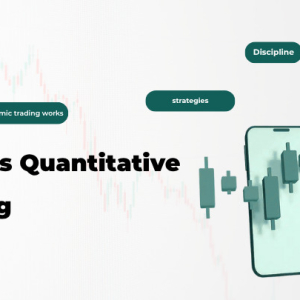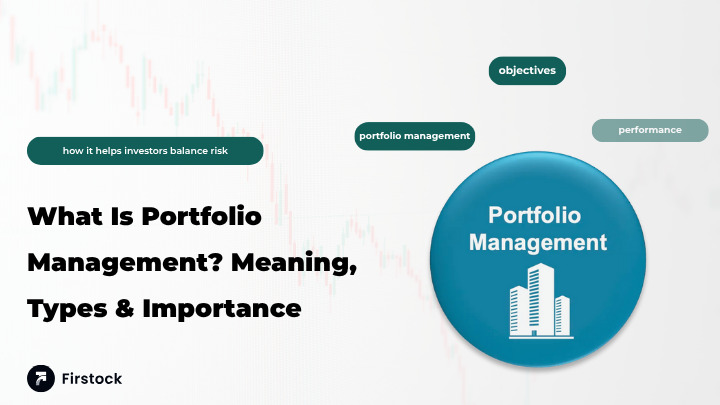What is Portfolio Management: A Complete Guide for Smart Investors
Ever wondered how successful investors manage to grow their wealth steadily without losing sleep over market ups and downs? The answer lies in one powerful concept — Portfolio Management. Think of it like tending a garden: you plant different seeds (investments), water them (monitor performance), prune when necessary (rebalance), and patiently watch them flourish over time.
In this article, we’ll explore what is portfolio management, its objectives, types, and how you can use the best trading app in India to simplify your investment journey.
Discover what is portfolio management, objectives of portfolio management, types of portfolio management, and how a trading app in India can help you manage investments smartly.
Introduction to Portfolio Management
When you think about investing, the first question that pops up might be — “Where should I put my money?” But a wiser question would be — “How should I manage all my investments together?”
That’s where portfolio management comes in. It’s the art and science of managing your investments so they work together efficiently, just like an orchestra where every instrument (asset) contributes to the perfect harmony of your financial goals.
What is Portfolio Management?
Portfolio Management refers to the process of strategically selecting and managing a collection of financial assets — such as stocks, bonds, mutual funds, and other securities — to achieve specific financial objectives.
In simple terms, it’s about balancing risk and return. A good portfolio doesn’t just aim for high profits; it also focuses on protecting your investments from market volatility.
Imagine you’re building a cricket team. You need batsmen (growth stocks), bowlers (bonds), and all-rounders (mutual funds) to win the game. Portfolio management ensures you have the right mix on your team.
Why is Portfolio Management Important?
Here’s why it matters:
- Diversification reduces risk.
- Goal alignment ensures your money works towards your dreams — whether it’s buying a house, retirement, or your child’s education.
- Performance tracking keeps you informed and in control.
- Risk management helps you survive market downturns.
Without portfolio management, your investments might feel scattered and reactive instead of strategic and purpose-driven.
Objectives of Portfolio Management
The objectives of portfolio management are the guiding principles that shape every decision you make as an investor.
a) Capital Appreciation
The primary aim is to increase the overall value of your investments over time.
b) Risk Minimization
By diversifying across assets, sectors, and geographies, portfolio management reduces exposure to market shocks.
c) Liquidity
A well-structured portfolio ensures you can access funds when needed without heavy losses.
d) Consistent Returns
Rather than chasing quick profits, portfolio management focuses on generating steady returns.
e) Tax Efficiency
It also considers investment instruments that offer better post-tax returns.
Key Components of a Portfolio
A portfolio typically includes a mix of the following:
- Equities (Stocks): Offer growth potential but come with higher risk.
- Debt Instruments (Bonds): Provide stability and regular income.
- Mutual Funds: Combine diversification and professional management.
- ETFs: Low-cost, easy-to-trade investment options.
- Commodities (Gold, Silver): Act as a hedge against inflation.
- Cash & Equivalents: Maintain liquidity for short-term needs.
The right mix depends on your risk appetite, investment goals, and time horizon.
Types of Portfolio Management
There’s no one-size-fits-all strategy. Let’s explore the types of portfolio management that investors use:
a) Active Portfolio Management
Here, the manager makes frequent buy-sell decisions to outperform the market. It requires expertise, research, and constant monitoring.
b) Passive Portfolio Management
In this approach, the portfolio mirrors a market index like Nifty 50. It’s less risky and more cost-effective.
c) Discretionary Portfolio Management
The investor entrusts all decisions to the portfolio manager, who handles everything professionally.
d) Non-Discretionary Portfolio Management
The manager gives advice, but the investor makes the final call on trades.
Each type suits different investor personalities and comfort levels.
Active vs. Passive Portfolio Management
Let’s break down the difference:
|
Aspect |
Active Management |
Passive Management |
|
Goal |
Beat the market |
Match the market |
|
Cost |
Higher fees |
Lower fees |
|
Risk |
Higher (depends on decisions) |
Lower (tracks index) |
|
Effort |
Continuous monitoring |
Minimal involvement |
|
Ideal For |
Experienced investors |
Beginners or long-term holders |
In short, if you love tracking markets, go active. If you prefer a “set it and forget it” approach, passive might suit you better.
Steps Involved in Portfolio Management
Managing a portfolio isn’t just about buying stocks — it’s a structured process:
1. Identifying Goals
Define what you’re investing for — short-term gains, retirement, or wealth creation.
2. Assessing Risk Tolerance
Know how much volatility you can handle without panic-selling.
3. Asset Allocation
Distribute funds across equities, debt, and other assets based on your goals.
4. Security Selection
Choose the right stocks, bonds, or funds within each asset class.
5. Monitoring and Rebalancing
Regularly review performance and make adjustments as needed.
Benefits of Effective Portfolio Management
When done right, portfolio management offers several advantages:
- Optimized Returns: Balances growth and safety.
- Reduced Risk: Spreads exposure across different investments.
- Better Financial Discipline: Encourages goal-based investing.
- Peace of Mind: You know your money is working efficiently.
- Professional Guidance: Expert managers or advanced trading apps can simplify complex decisions.
Risks Associated with Portfolio Management
Even the best portfolios carry risks. Understanding them helps you prepare better:
- Market Risk: Fluctuations in prices can impact returns.
- Interest Rate Risk: Rising rates may affect bond prices.
- Liquidity Risk: Difficulty in selling assets quickly.
- Inflation Risk: Erodes purchasing power.
- Manager Risk: Over-reliance on the portfolio manager’s skill.
Mitigating these risks involves diversification, regular monitoring, and using trustworthy tools.
Role of Technology and Trading Apps in India
Thanks to technology, managing a portfolio is no longer just for the wealthy. Modern trading apps in India like Firstock, Zerodha, Groww, and Angel One have made investing more accessible and efficient.
Here’s how:
- Zero or low brokerage options save costs.
- Real-time analytics and AI-based insights help track portfolio performance.
- User-friendly dashboards simplify asset allocation.
- Educational tools guide beginners in making smarter investment decisions.
Whether you’re a student or a seasoned investor, a trading app in India can act as your digital portfolio manager.
Common Portfolio Strategies Used by Investors
Here are some tried-and-tested strategies:
- Growth Strategy: Focuses on high-growth stocks.
- Income Strategy: Targets dividend-paying assets.
- Value Investing: Looks for undervalued companies.
- Balanced Strategy: Mix of growth and income investments.
- Aggressive vs. Defensive Strategies: Based on market outlook and investor temperament.
Mistakes to Avoid in Portfolio Management
Even smart investors make mistakes. Avoid these pitfalls:
- Lack of diversification — don’t put all eggs in one basket.
- Emotional investing — fear and greed can cloud judgment.
- Ignoring rebalancing — markets change, and so should your portfolio.
- Chasing trends — what’s hot today may cool tomorrow.
- Neglecting risk assessment — always know your comfort zone.
How to Choose the Right Portfolio Manager or App
Consider these factors before trusting your money with someone (or something):
- Credibility and Track Record — Check reviews and ratings.
- Transparency — Understand fees and performance metrics.
- Ease of Use — The app or manager should simplify, not complicate.
- Support and Education — Helpful customer support and learning resources.
Among the top choices, Firstock, one of the best trading apps in India, offers a zero-brokerage model, fast execution, and comprehensive tools for portfolio management.
Conclusion
In a nutshell, portfolio management is not about predicting the market; it’s about preparing for it. Whether you choose to manage your portfolio personally or through a professional or app, the key lies in discipline, diversification, and continuous learning.
Just as a captain steers a ship through calm and stormy seas alike, a well-managed portfolio helps you navigate financial waves with confidence.
So, start small, stay consistent, and let your investments grow into your dream financial garden.
FAQs
1. What is portfolio management in simple words?
Portfolio management means managing all your investments — like stocks, mutual funds, and bonds — in a way that balances risk and return.
2. What are the objectives of portfolio management?
The main objectives are capital growth, risk reduction, liquidity, consistent returns, and tax efficiency.
3. What are the different types of portfolio management?
There are four main types: active, passive, discretionary, and non-discretionary portfolio management.
4. How can I manage my portfolio effectively?
By setting clear goals, diversifying investments, monitoring regularly, and using reliable trading apps in India.
5. Which is the best trading app in India for portfolio management?
Apps like Firstock, Groww, and Zerodha are among the best options for managing and tracking your portfolio efficiently.




